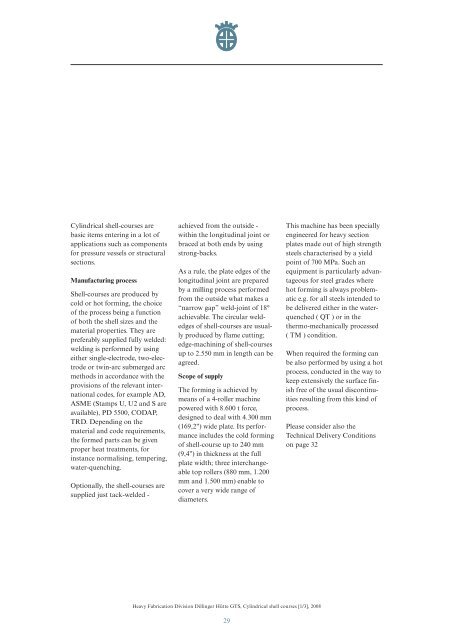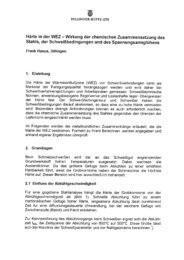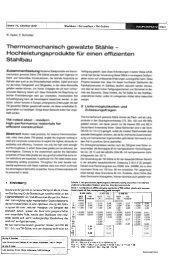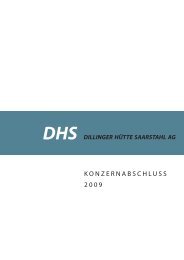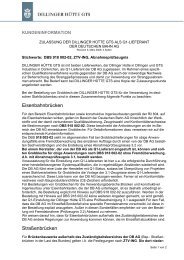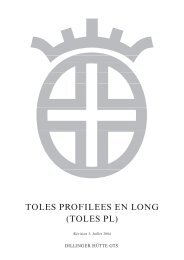Delivery program "Heavy Fabrication Division" - Dillinger Hütte GTS
Delivery program "Heavy Fabrication Division" - Dillinger Hütte GTS
Delivery program "Heavy Fabrication Division" - Dillinger Hütte GTS
You also want an ePaper? Increase the reach of your titles
YUMPU automatically turns print PDFs into web optimized ePapers that Google loves.
Cylindrical shell-courses are<br />
basic items entering in a lot of<br />
applications such as components<br />
for pressure vessels or structural<br />
sections.<br />
Manufacturing process<br />
Shell-courses are produced by<br />
cold or hot forming, the choice<br />
of the process being a function<br />
of both the shell sizes and the<br />
material properties. They are<br />
preferably supplied fully welded:<br />
welding is performed by using<br />
either single-electrode, two-electrode<br />
or twin-arc submerged arc<br />
methods in accordance with the<br />
provisions of the relevant international<br />
codes, for example AD,<br />
ASME (Stamps U, U2 and S are<br />
available), PD 5500, CODAP,<br />
TRD. Depending on the<br />
material and code requirements,<br />
the formed parts can be given<br />
proper heat treatments, for<br />
instance normalising, tempering,<br />
water-quenching.<br />
Optionally, the shell-courses are<br />
supplied just tack-welded -<br />
achieved from the outside -<br />
within the longitudinal joint or<br />
braced at both ends by using<br />
strong-backs.<br />
As a rule, the plate edges of the<br />
longitudinal joint are prepared<br />
by a milling process performed<br />
from the outside what makes a<br />
“narrow gap” weld-joint of 18°<br />
achievable. The circular weldedges<br />
of shell-courses are usually<br />
produced by flame cutting;<br />
edge-machining of shell-courses<br />
up to 2.550 mm in length can be<br />
agreed.<br />
Scope of supply<br />
The forming is achieved by<br />
means of a 4-roller machine<br />
powered with 8.600 t force,<br />
designed to deal with 4.300 mm<br />
(169,2") wide plate. Its performance<br />
includes the cold forming<br />
of shell-course up to 240 mm<br />
(9,4") in thickness at the full<br />
plate width; three interchangeable<br />
top rollers (880 mm, 1.200<br />
mm and 1.500 mm) enable to<br />
cover a very wide range of<br />
diameters.<br />
<strong>Heavy</strong> <strong>Fabrication</strong> Division <strong>Dillinger</strong> <strong>Hütte</strong> <strong>GTS</strong>, Cylindrical shell courses [1/3], 2008<br />
29<br />
This machine has been specially<br />
engineered for heavy section<br />
plates made out of high strength<br />
steels characterised by a yield<br />
point of 700 MPa. Such an<br />
equipment is particularly advantageous<br />
for steel grades where<br />
hot forming is always problematic<br />
e.g. for all steels intended to<br />
be delivered either in the waterquenched<br />
( QT ) or in the<br />
thermo-mechanically processed<br />
( TM ) condition.<br />
When required the forming can<br />
be also performed by using a hot<br />
process, conducted in the way to<br />
keep extensively the surface finish<br />
free of the usual discontinuities<br />
resulting from this kind of<br />
process.<br />
Please consider also the<br />
Technical <strong>Delivery</strong> Conditions<br />
on page 32


